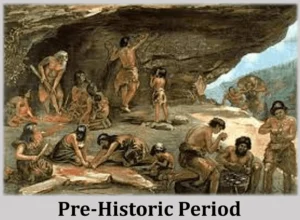
The period or phase of history where we do not have any written evidence is termed as pre-Historic period. So dear reader I’ll make you dive back into the time and peep into this pre-historic phase through this blog.
The evolution of the Earth’s Crust is divided in 4 periods. Geographically the last period is known as the Quaternary period is divided into two epochs the Pleistocene and the Holocene. The Pleistocene largely corresponds with the ice age when the earth’s crust was covered with thick sheet of ice. The earliest evidence of human evolution can be traced back to the Pleistocene period in the region of Vindhyas. With evolution of human being story of human progress began which is largely the ingredient of history.
The Paleolithic Age
Human being in the Pleistocene phase began to hunt larger animals for the survival with the help of larger stone tools. This marked the beginning of the Stone Age culture in the India known as Paleolithic Age that continued form 500,000 BC to 10000 BC.
By 10,000 BC this came to an end, which even led to the termination of Pleistocene phase. With the end of the Ice Age, climate became relatively warm and humid, and the new areas got exposed to the human beings. After the gap, 1000 years and intermediate phase known as Mesolithic age started around 9000BC and continued till 4000 BC. Largely this phase corresponds with the Holocene phase which this continues till today.
The Mesolithic Age
The Mesolithic phase is known to the contemporary world through the art of painting performed by people in the large number of rock shelters. This phase is marked by an important performing art i.e., painting. The large number of rock shelters were discovered after Indian India’s independence by Vishnu Shridhar Wakankar at Bhimbetka in Madhya Pradesh.

In all 750 rock shelters were discovered in the spam of 12 years by a team of archeologist. Out of 750 almost 500 provide the evidence of the earliest mural paintings. These painting depict the lavish use of white and red colour depicting the hunting, child delivery, fire and even certain mythological animals like bulls horses and rhinoceros.
Further on account of permanent painting global experts have accepted the site of Bhimbetka as world heritage site in the intangible category. This site was included by UNESCO in 2003 to indicate the noble at Bhimbetka to be preserved for future generations. UNESCO has included 40 Indian sites in the list of World Heritage sites in which maximum sites are located in Maharashtra.
During Mesolithic phase, people began to hunt smaller animals with smaller stone tools known as microliths. Manufactured through the technique of flacking. Maximum number of microliths are found at Bagor (Rajasthan) Originally on the banks of river Kothari.
The Neolithic age
The Mesolithic phase was followed by the Neolithic age. Neolithic age started around 4000 BC and continued till 2500 BC. During this phase polished stone tools began to be used by mastering the technique of flaking. Such tools facilitated hunting of animals.

However, the most progressive development was practice of agriculture which started at Mehrgarh( Pakistan). With practice of agriculture people began to manufacture handmade pottery to store surplus food grains.
Agricultural productivity grew considerably with time, and this led to the construction of granaries. Such development ensured food security. Therefore, large section of people began to focus on diverse art and crafts supplemented by internal and external trade. This resulted into first urbanization in India confined to the Indus valley.
Geographically this cultural peak is termed as Indus Valley Civilization. Technically it is known as bronze age civilization due to the technique of producing bronze by mixing copper and tin. It is also known as Harappan Civilization as Harappa was the first site to be excavated in 1922.

You have made things easy for layman to understand ancient history .
Very nicely explained 👍
Very good article
I almost forgot these. Looking forward to reading more such articles.